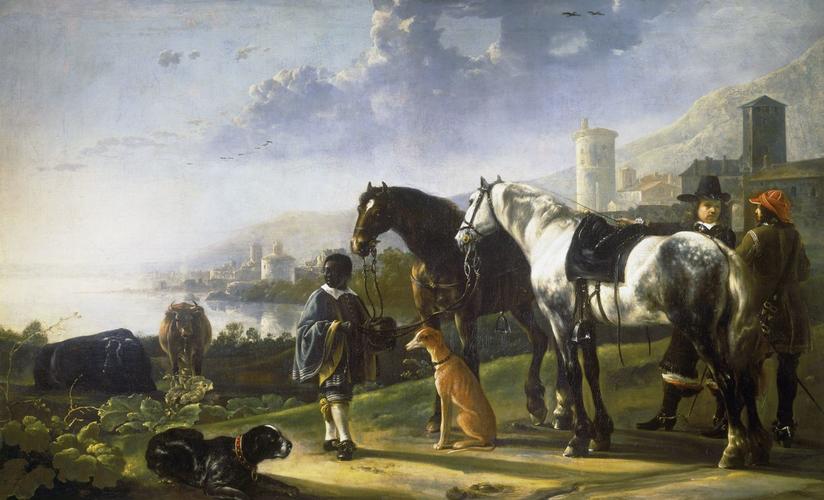-
1 of 253523 objects
A Page with Two Horses c.1655-60
Oil on canvas | 143.2 x 228.1 cm (support, canvas/panel/stretcher external) | RCIN 405319
-
The real or would-be aristocratic character of Cuyp’s clientele explains the popularity in his oeuvre of riding and hunting portraits. It has been suggested that the nobleman here, wearing black and attended by his groom and page, is a portrait and may be identified as Willem van Beveren, son of Cornelis van Beveren, who was knighted by Louis XIII in 1635. The background architecture is certainly of the type used in the equestrian portraits; however the man in black is half hidden by his horse and upstaged by his page, neither of which suggests the prominence one might expect from a portrait. The alternative is that this is a general evocation of journeying south. The scale of this painting may seem rather grand for an equestrian caprice rather than an equestrian portrait, but in fact the decorative schemes which became a feature of Dutch painting in the later years of the seventeenth century are almost always grand in scale and imaginary in subject.
There are many examples in Dutch art of literal-minded episodes, where the actions match the setting. This painting is rather more allusive and open-ended: to make sense of the scene we are to imagine that the horsemen have ridden all day and arrived at a strange town where their horses are tended by their own or their host’s page – in other words the event we see here should be taking place in the courtyard of one of the castles or inns in the background. Instead it has been improbably transposed to a place outside the city gates to convey the journeying as well as the arriving.Provenance
Purchased by George IV in 1809; may have belonged previously to Benjamin West; recorded in the Rose Satin Room at Carlton House in 1819 (no 33); in the Picture Gallery at Buckingham Palace in 1841 (no 129)
-
Creator(s)
(nationality)Acquirer(s)
-
Medium and techniques
Oil on canvas
Measurements
143.2 x 228.1 cm (support, canvas/panel/stretcher external)
159.6 x 244.6 cm (frame, external)
Other number(s)
Alternative title(s)
The Negro Page [historic title]
